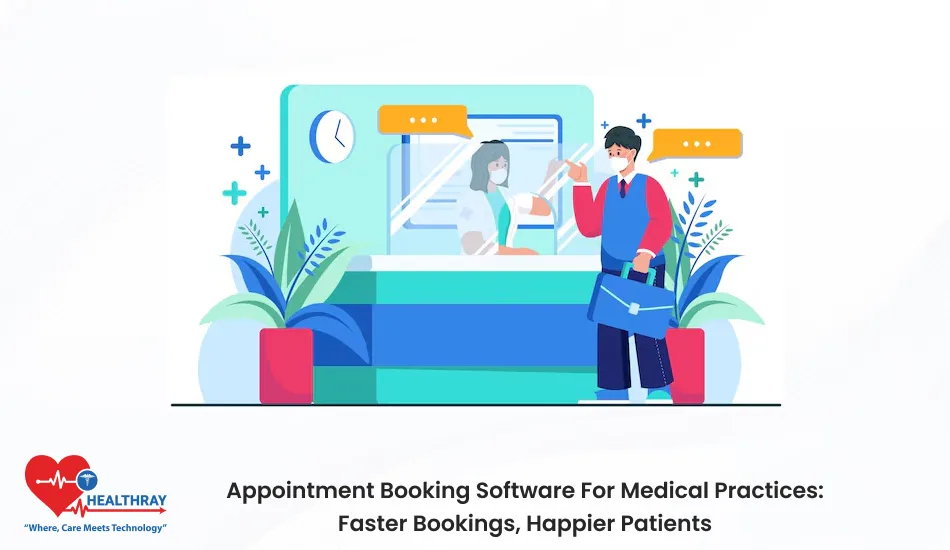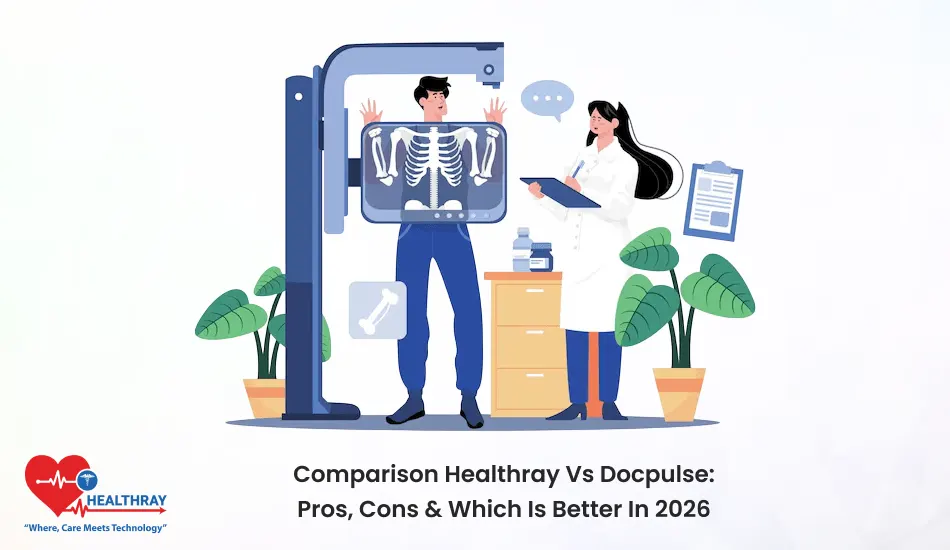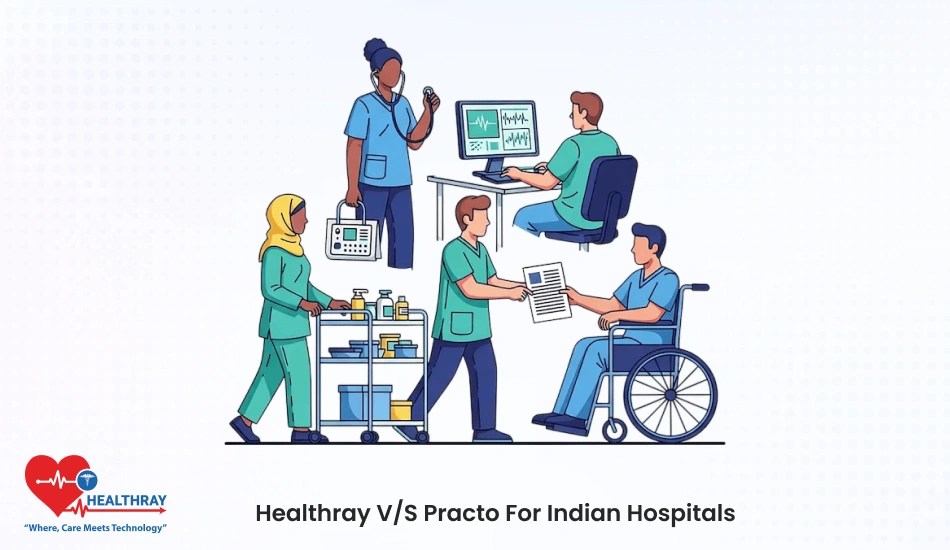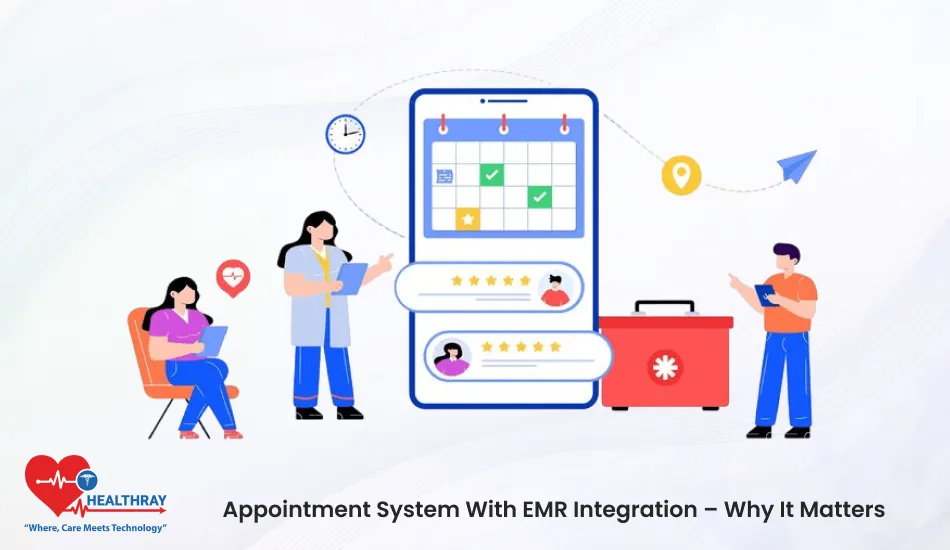Summary
The mobile EMR app is changing how clinicians deliver care, making it more efficient, smarter, and available anywhere. In contrast to traditional EMR software, it has real-time access to patient data, instant updates and seamless collaboration across departments.
The advantages of EMR software are increased when mobility, security and collaboration converge through hybrid EMR deployment models. The app empowers patients, improves accuracy, and stifles paperwork in the hospital. These hospitals now have EMR systems that fit in a patient’s pocket. Just want to see how this innovation changes everyday life? Read this article and experience healthcare’s digital heartbeat.
Introduction
Every second counts in today’s hospital edifice, and so does immediate access to patient information. This is where the mobile EMR app comes in, revolutionizing how clinicians access care data on the go.
Unlike typical EMR software, this tool can work anywhere, and not just on a desktop or workstation. It moves with clinicians, from wards to clinics to emergency rooms; thus, any vital information is always a tap away.
A mobile EMR app makes it easy to check results, to update patient notes, or to transmit e-prescriptions. More importantly, it helps clinicians make decisions faster, safer, and smarter in real time. More than the convenience, it adds a cadence to health care, one based on mobility, precision and speed. No waiting, no mess, just clean connected care when and where you need it.
The digital revolution of healthcare is not just coming; it is here, and the mobile EMR app is central to this transformation. Let’s explore how it empowers clinicians to deliver great patient care.
What’s Mobile EMR App?

A mobile EMR app is, in essence, a portable version of EMR software developed for smartphones and tablets. It enables doctors to access patient records and update them anytime and from anywhere. In fact, this app brings complete medical data to a clinician’s pocket, unlike traditional EMR systems of hospitals that can only be accessed from desktops.
Furthermore, using a mobile EMR app, physicians can check lab reports, write notes, make medicine prescriptions, and also interact in real time with teams. Consequently, the advantages of EMR software are compounded when mobile flexibility is added, enabling quicker updates, fewer errors, and enhanced patient satisfaction.
In addition, most healthcare institutions now have hybrid EMR deployment models, where on-premise and cloud-based solutions are combined for secure and seamless data transfer. Ultimately, a mobile EMR app connects technology with care; it keeps clinicians informed, productive, and connected while on the go.
Why Clinicians Love Mobile EMR App?
Today’s clinician is faced with a fast-paced environment where speed, accuracy, and real-time access define successful patient care. Their most trusted partner has been the mobile EMR app, which, in turn, puts the power of data at their fingertips whenever and wherever it is needed.
Freedom from Desks and Computers
Conventional EMR software has the drawback of tying clinicians to stationary workstations. Therefore, they log in, search through screens, and go in and out of tabs to see one patient file.
However, the mobile EMR app transforms this practice entirely. It enables doctors, nurses, and specialists to have information about patients in their pockets. As a result, they can check vitals, read lab results, and note progress as they walk between wards or even on home visits. This mobility not only keeps the work flowing, but also saves a bit of time that used to be spent returning to a desk after each visit. So, the advantages of EMR software increase due to mobility.
Real-Time Patient Data for Smarter Decisions
When every second counts, instantaneous access to information is vital. In particular, a portable EMR application allows for real-time patient information at the time of care. For instance, instead of waiting for the system to download files or relying on paper notes, clinicians can access lab results, imaging reports, and medication histories in real-time.
Consequently, this immediacy helps them make quicker, safer, and more personalized choices. To illustrate, consider this scenario: A patient’s blood test is ready while the physician is still doing rounds. Therefore, the clinician can see those results in real-time on the app, change treatment orders, and alert the care team within minutes.
On the other hand, the mobile version eliminates any lag in information flow and availability that older EMR systems of hospitals could experience while trying to get information to sync or update in the different departments.
Enhanced Collaboration Across Teams
Health care is never solitary. The mobile EMR app fosters improved collaboration by linking all members of the care team, from physicians to nurses to lab technicians. Because everyone is accessing the same digital files, everyone is on the same page.
For instance, if a physician writes a new prescription in a patient’s chart, the nurse is notified immediately. Similarly, when lab results come in, both the treating doctor and the consulting specialist see them simultaneously. This uninterrupted flow of information minimizes uncertainty and avoids lag in action, while also guaranteeing that all professionals base their interventions on the most up-to-date data.
The advantages of EMR software in this case are not just in convenience, but in coordination and accountability. That is, when paired with hybrid EMR deployment models, cross-departmental/cross-facility/cross-regional teams can collaborate and work together in a secure cloud-enabled environment without relinquishing authority over sensitive patient information.
Less Paperwork, More Patient Interaction
Clinicians used to waste hours charting, tracking down lab reports, and signing forms long before EMR systems; however, they still had to have desktops or paper notes between patients, even with basic EMR software. Nevertheless, the mobile EMR app completely changes this.
Now, consequently, they can document notes, update charts, and sign electronic prescriptions in real time during patient visits. Additionally, nurses can enter vitals at the bedside on their phones or tablets, and it syncs automatically with the central EMR systems of hospitals.
Moreover, there are no more pieces of paper and more in-person interaction, which results in less time spent in front of screens. As a result, clinicians can concentrate on patients rather than on documentation. This transformation is a means to improve the quality of care and strengthen trust and satisfaction among patients.
Furthermore, the advantages of EMR software, specifically, accuracy, completeness, and legibility, are compounded with mobile access. Thus, there are no lost files or signatures or handwriting. In particular, all updates remain digital, filed, and easily searchable.
Improved Security and Flexible Deployment
One of the biggest concerns in healthcare digitization is data security. Clinicians work with highly sensitive information about patients and any breach can cause serious harm. This is the reason modern mobile EMR app features advanced security measures such as data encryption, multi-factor authentication and role-based access control.
Unlike the oldest EMR systems of hospitals, which are hosted on internal servers and run with minimal surveillance, the mobile version has security both locally and in the cloud. With hybrid EMR deployment models, it is possible for hospitals to house sensitive information locally in a secure manner while allowing for encrypted access from the cloud for authorized personnel. This dual approach provides flexibility and protection.
The mobile EMR app also aids medical institutions in complying with stringent regulatory mandates such as HIPAA. Clinicians feel they can find what they need without compromising patient privacy. Patients, in turn, benefit from knowing their information remains secure in each and every engagement. This level of safety, flexibility, and reliability makes the mobile EMR app more than a tool; it is a trusted link between technology and compassionate care.
Case Example: A Day in a Doctor’s Life with a Mobile EMR App

Dr. Meera Sharma starts her morning at 7:30 a.m. She knows exactly how to be in every moment. As the lead physician in one of the busiest EMR systems in Mumbai, she knows every minute is valuable. In previous years, she started her day by entering the hospital’s EMR software on a desktop, printing reports, scanning through physical files, and then seeing her first patient. But now, the situation looks very different, thanks to the mobile EMR app on her tablet.
Dr. Meera checks her list for patients that are on her schedule before she makes them into the hospital. The mobile EMR app instantly adds to the hospital’s main EMR system and shows her real-time updates of lab results, vitals, and medications. She sees that one of her diabetic patients, Mr. Kapoor, had his fasting glucose test just 10 minutes ago. One tap, she reads the report and adjusts his insulin consumption before arriving in her office.
She starts her ward rounds at 9:00 am. She is only carrying her tablet rather than large folders. She moves from bed to bed and opens each patient’s profile in seconds. The advantages of EMR software become evident – organized data sheets, notes, and accurate medical history accessible via instant access.
When she visits Mrs. Fernandes, a cardiac patient recovering from surgery, she sees real-time alert on her screen. The mobile EMR app shows that Mrs. Fernandes‘ blood pressure spiked 15 minutes ago. Dr. Meera checks the chart for readings, compares latest readings and quickly adds a new medication order. In case the nurse ever goes out of the room, she receives an instant notification on her own mobile device.
At lunch time, Dr. Meera receives a call from outpatient clinic in another unit of the hospital group. Certainly, she needs a quick response in another case. Through hybrid EMR deployment models, she logs into the cloud, checks the patient’s history, and sends suggestions within minutes of signing in. It’s not necessary for her to wait for files to be transferred or scanned. The system is continuously updated across all the associated facilities.
By 3:00 p.m., Dr. Meera follows the video of a patient who recently underwent a minor procedure. She uses the mobile EMR app during the session to access surgical notes, photos of wounds, and to prescribe antibiotics online. It syncs with the pharmacy module of the EMR systems for hospitals to ensure medication is ready before the patient arrives.
With her day over, Dr. Meera goes through her notes to check for quality. The app summarizes entries, flags incomplete sections, and saves them to the safe server. No more typing, no paperwork, no file hunting.
She smiles when she leaves home, but one simple truth: technology doesn’t replace her care; it empowers her. She had a mobile EMR application that provided speed, accuracy and freedom. So, she now has faster, smarter, and truly connected care for every patient.
Conclusion
The mobile EMR app is not just a tool, it is a movement towards more connected, patient-centered healthcare. It brings the benefits of EMR software to freedom, flexibility and precision. It’s an intersection between care, time, and technology that emerges in the modern EMR systems of hospitals.
It is supported by secure hybrid EMR deployment models, which transform each doctor‘s device into an intelligent medical assistant. It is a way for clinicians to be mobile, patients to be informed and data to flow smoothly without friction.





